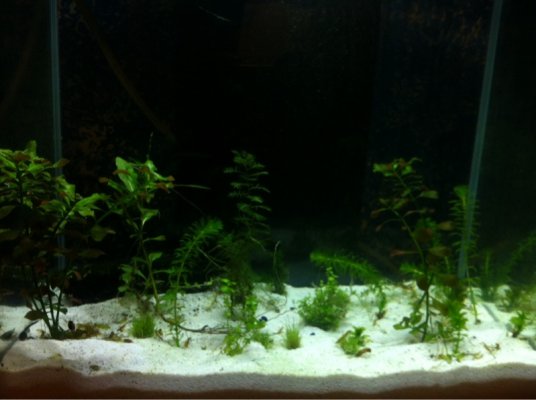Could you link to some of the fixtures or LEDs you're looking at? That'd help me give useful advice!
I'm not trying to be obtuse, but you can't usefully specify aquarium lighting in watts of electrical power any more -- this hasn't been possible since incandescent bulbs were replaced by fluorescent and it's even worse now that LEDs are popular. Quite simply, you can drive two different "warm-white" LEDs at 1W and get four times more light out of one or the other!
Heck, you can drive the SAME LED at one watt and get more light out of it (and longer lifetime) if you add a large heatsink!
Clearly this makes choosing lighting a much more complicated task. I'm sorry about that, but there are a couple ways to simplify your life, especially if you're looking to purchase commercial fixtures.
Just to make it a bit more complicated, chlorophyll absorbs more red and blue and less green (the reason plants tend to be green) and "PAR" does a pretty good job of taking this into account for the average aquarium plant.
You probably want a PAR of 30 to 50 at the substrate, and for most broadband light sources, you can multiply that by 50 to get a rough estimate of lux needed at the substrate (power per unit area).
This is just a rough estimate, but I'd shoot for around 2,500 lux at the substrate with your LEDs. This is pretty easy to measure with a light meter (a much cheaper unit than a specialized PAR meter) but if you're shopping for fixtures that won't help too much so you need to convert lux to lumens, and you get around 6000 lumens at 17 inches.
I cut a lot of corners in that explanation for the sake of brevity (i.e. neglecting the impact of photopic curves on measures of luminous intensity) but if you're looking at commercially available LED lighting for your tank,
you'll need around 6000 lumens. You might be able to get by with half that, especially if you make sure to avoid plants that have high light requirements, but only try it if you have an upgrade path in case it turns out to be too little light.
Yes, that is a lot of light and it'll be pricey! If you get about 80 lumens per electrical watt from your LEDs, you can expect to need 75 Watts of LED lighting to grow plants
If you're just looking at buying LED bulbs or fixtures, this should be enough information as LED bulbs are sold advertising lumens output. Make sure that all the LEDs are pointing toward the water as with floodlights as otherwise much of that will be wasted!
For more information on lighting aquariums (although not addressing LEDs) I'd suggest reading this article:
Aquarium plant lighting - Aqua Botanic's Aqua Bloggin
Good luck!

